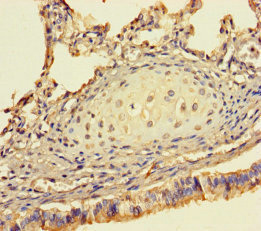
Immunohistochemistry of paraffin-embedded human prostate cancer using CSB-PA021263LA01HU at dilution of 1:100
SEM1 Antibody
CSB-PA021263LA01HU
ApplicationsELISA, ImmunoHistoChemistry
Product group Antibodies
ReactivityHuman
TargetSEM1
Overview
- SupplierCusabio
- Product NameSEM1 Antibody
- Delivery Days Customer20
- ApplicationsELISA, ImmunoHistoChemistry
- CertificationResearch Use Only
- ClonalityPolyclonal
- ConjugateUnconjugated
- Gene ID7979
- Target nameSEM1
- Target descriptionSEM1 26S proteasome subunit
- Target synonymsC7orf76, DSS1, ECD, PSMD15, SHFD1, SHFM1, SHSF1, Shfdg1, 26S proteasome complex subunit SEM1, 26S proteasome complex subunit DSS1, SEM1 26S proteasome complex subunit, deleted in split hand/split foot protein 1, deleted in split-hand/split-foot 1, split hand/foot deleted protein 1, split hand/foot malformation (ectrodactyly) type 1, split hand/foot malformation type 1 protein
- HostRabbit
- IsotypeIgG
- Protein IDP60896
- Protein Name26S proteasome complex subunit SEM1
- Scientific DescriptionComponent of the 26S proteasome, a multiprotein complex involved in the ATP-dependent degradation of ubiquitinated proteins. This complex plays a key role in the maintenance of protein homeostasis by removing misfolded or damaged proteins, which could impair cellular functions, and by removing proteins whose functions are no longer required. Therefore, the proteasome participates in numerous cellular processes, including cell cycle progression, apoptosis, or DNA damage repair (PubMed:15117943). Component of the TREX-2 complex (transcription and export complex 2), composed of at least ENY2, GANP, PCID2, SEM1, and either centrin CETN2 or CETN3 (PubMed:22307388). The TREX-2 complex functions in docking export-competent ribonucleoprotein particles (mRNPs) to the nuclear entrance of the nuclear pore complex (nuclear basket). TREX-2 participates in mRNA export and accurate chromatin positioning in the nucleus by tethering genes to the nuclear periphery. Binds and stabilizes BRCA2 and is thus involved in the control of R-loop-associated DNA damage and thus transcription-associated genomic instability. R-loop accumulation increases in SEM1-depleted cells.
- ReactivityHuman
- Storage Instruction-20°C or -80°C
- UNSPSC41116161




